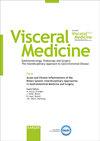Medical Therapy of Perianal Crohn's Disease
引用次数: 11
Abstract
Background: Development of perianal fistulas are a common feature of Crohn's disease (CD). Consequences are severe impairment of quality of life as well as potentially life-threatening complications like abscess formation or bacterial sepsis. Therefore, appropriate treatment is an important task in the management of CD. Methods: This review describes the epidemiology, pathogenesis, diagnosis, and conservative medical treatment of perianal CD with regard to the available literature. In February 2015, a PubMed search was performed with the following terms (combined and separate): ‘Crohn's disease management', ‘Crohn's disease complications', ‘perianal Crohn's disease', ‘fistulizing Crohn's disease', ‘perianal fistulas', ‘fistula healing', ‘fistula closure'. From the search results, 36 articles were chosen as core elements of this review. Results: Pelvic magnetic resonance imaging and rectal endosonography are established diagnostic approaches to evaluate perianal fistulas in conjunction with endoscopy. Antibiotics, thiopurines, and calcineurin inhibitors are useful agents in the management of perianal CD. The availability of anti-TNF-alpha therapies has substantially changed the prospects and goals of medical treatment, and fistula healing seems to be possible in a substantial proportion of patients. Conclusion: Antibiotics and several immunosuppressive drugs have improved the treatment of fistulizing CD and should be combined with surgical measures.肛周克罗恩病的医学治疗
背景:肛门周围瘘管的发展是克罗恩病(CD)的共同特征。其后果是生活质量严重受损,以及可能危及生命的并发症,如脓肿形成或细菌性败血症。因此,适当的治疗是管理CD的重要任务。方法:本文综述了现有文献中肛周CD的流行病学、发病机制、诊断和保守治疗。2015年2月,在PubMed上搜索了以下术语(合并和单独):“克罗恩病管理”、“克罗恩病并发症”、“肛周克罗恩病”、“瘘管愈合”、“瘘管闭合”。从检索结果中选择36篇文章作为本综述的核心要素。结果:盆腔磁共振成像和直肠超声检查结合内镜检查是评估肛周瘘的可靠诊断方法。抗生素、硫嘌呤和钙调磷酸酶抑制剂是治疗肛周CD的有效药物。抗tnf - α疗法的可用性大大改变了医学治疗的前景和目标,并且在相当大比例的患者中,瘘管愈合似乎是可能的。结论:抗生素和多种免疫抑制药物改善了瘘管性乳糜泻的治疗效果,应与手术措施相结合。
本文章由计算机程序翻译,如有差异,请以英文原文为准。
求助全文
约1分钟内获得全文
求助全文

 求助内容:
求助内容: 应助结果提醒方式:
应助结果提醒方式:


